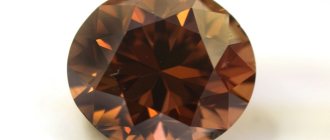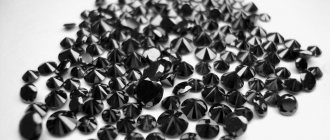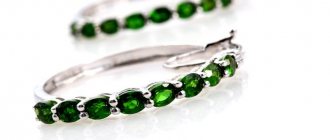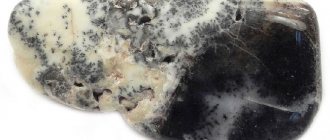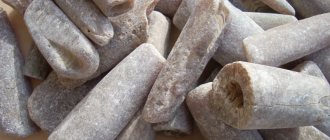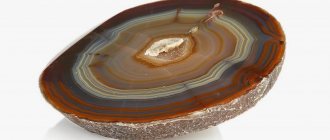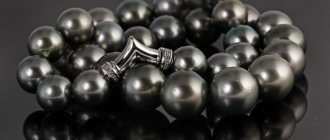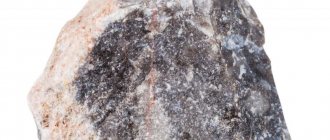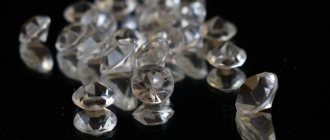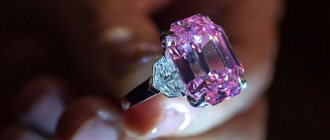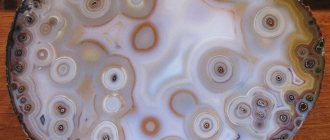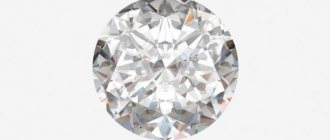A yellow diamond is a diamond that differs from the usual clear diamond in color. About 90% of natural diamonds, called “yellow,” have a slight yellowish tint, and only 10% of the remaining stones have a clear yellow color. For such truly unique crystals, a classification group was identified - fantasy.
There are actually a number of “names” that yellow fancy diamonds have come to be called over time. The smallest number of yellow stones are called canary stones, while others, simpler ones, are called ordinary stones. A canary stone has an intense, bright yellow color, while a regular diamond has a faint yellow tint.
Yellow Diamond and its stories
Not every yellow diamond is expensive. Sometimes a sunny color is a sign of a decrease in price, but a bright, rich tonality is a factor in its increase. Pronounced yellow is a sign of belonging to fantasy stones. These are rare, sold at auctions and cost thousands and even millions of dollars.
Formation process and coloring
A yellow diamond (diamond) is a stone whose color is determined by its structure and impurities. The crystal lattice of the transparent mineral contains carbon, the yellowish tint is the result of nitrogen atoms. The higher the percentage of impurity, the brighter the color of the formation. At the same time, the properties of the mineral are preserved.
Origin
Reference. Scientists still haven't decided how many thousands or millions of years it takes nature to create colored diamonds. But mineralogists claim that special conditions are needed for the birth of the king of crystals.
Deep in the earth's crust there must be not only high temperature, but also a certain pressure. In such a furnace, a diamond is produced from carbon and nitrogen. And the addition of ferrous minerals gives the indestructible stone a lemon color.
Place of Birth
Precious yellow diamonds are found in some African deposits and in Australia. Occasionally they are found in Russian deposits. Stones with a rich hue are rare, so finding a gem is exceptionally lucky.
Most of it is mined in Africa. The main producers are mines in Angola, Congo, Central African Republic and Sierra Leone. Later, yellow crystals began to be found in Brazilian, Australian outcrops and on the island of Borneo.
For several decades, the leading supplier was the Ellendale mines in Australia - they provided half of the jewelry crystals. Now Yakutia, Canada, has reached the top in terms of production.
Yellow crystal
How important is cut?
When it comes to colored diamonds, cut is not as important as it is for white diamonds.
While regular colorless diamonds are cut to maximize their brilliance, colored diamonds are cut to maximize their color.
This is why the ideal cut proportions used for white diamonds do not apply to yellow ones.
For this reason, when choosing, you should first look at the color characteristics.
Once you've narrowed down your options, you can use cut as a secondary attribute to help you make your final purchasing decision.
Diamond properties
Diamond is one of the most expensive stones in the world. It is durable and cannot be scratched by other stones.
Properties of the mineral:
- stability in contact with concentrated acids;
- high resistance to heat;
- refraction up to 2.42 units;
- hardness 10 units;
- ability to scratch glass;
- high thermal conductivity.
Fantasy mineral
Classification of yellow diamonds
For classification, the international system presented by the American Gemological Center is used. When examining a transparent sample, it is weighed, the purity and brightness of the color, the quality of polishing, the cutting method, and color nuances are checked. When evaluating a fancy stone, only the color, purity of the mineral and its weight are studied. The first parameter is the most difficult to analyze. The final price of the stone depends on it - a weak yellow tone greatly reduces the cost, a bright color sharply increases it.
Carats
Special jewelry scales are used for weighing. When examining a sample, the jeweler checks not only the weight, but also the length of the stone. 0.01 carat – 1 mm, 0.02 carat – 1.7 mm, 1 carat – 6.4 mm. The larger and heavier the crystal, the higher the cost. A yellow diamond less than one carat is not uncommon, a one-carat example is a socially significant jewel, and jewelry with a stone larger than 2 carats is an exceptional rarity.
Weight is one of the factors in the assessment
Purity
Purity is an indicator of the transparency of a stone. Current classification:
- F-IF – pure crystal without impurities, defects inside and outside the stone;
- VVS1-VVS2 – pure sample with small inclusions;
- VS1-VS2 – stone with small inclusions;
- SI1-SI2 – crystal with inclusions that can be seen without magnifying optics;
- I1-I3 – the cheapest type, a crystal with large impurities.
Russia has adopted its own 12-step classification system. Stage 1 includes the purest samples, stages 9-12 include stones with impurities that are visible without magnification.
Color
For yellow fancy stone, color is a key grading factor. Experts divide tonality into 6 categories:
- Fancy Light Yellow;
- Fancy Yellow;
- Fancy Intense Yellow;
- Fancy Vivid Yellow;
- Fancy Deep Yellow;
- Fancy Dark Yellow.
There is a global system for assessing the quality of stone
The certificate accompanying any famous stone indicates the color code in accordance with the international classification system. The lightest is marked G, the richer the tone, the higher the level - each subsequent one is indicated by the next letter of the Latin alphabet. The most saturated color is Z.
Russia has adopted its own assessment system, which includes two classes:
- Class 1 – crystals weighing 0.01-0.29 carats, colored in tones from light to deep yellow;
- Class 2 – stones weighing 0.3 carats or more.
Intensity
Intensity is assessed on a 4-step scale:
- near colors (the lightest stones);
- faint yellow (saturation closer to medium);
- very light yellow (saturation slightly above average);
- light yellow (bright crystals).
In the jewelry world, bright yellow diamonds are called cape, slightly yellowish diamonds are called top cape, and specimens with a subtle yellowish tint are top crystal.
Cut
Cut is a factor in the evaluation of a clear diamond. When analyzing the properties and price of a fancy stone, the type of cut is not taken into account. All that matters is the quality of the work performed and the absence of defects.
Yellow – rare fantasy stones
Popular diamond cutting methods:
- circle;
- pear;
- oval;
- heart;
- marquis;
- baguette;
- emerald;
- princess.
Choice of carat.
Carat is an important factor in determining the price of a diamond.
It is known that larger diamonds are worth more; however, it is worth noting that colored stones of higher carats are disproportionately more expensive than smaller ones.
The main reason for this is that larger diamonds are much rarer and therefore a 2 carat yellow stone will be more than twice as expensive as a similar 1 carat one.
Keep this in mind when choosing a karat, and decide for yourself how much more money you are willing to pay for any additional karats.
Famous yellow diamonds
Jewelry with yellow diamonds is traditionally highly valued. Fancy stones are rare, expensive, and available only to a select few. The yellow stone symbolizes nobility and uniqueness.
Diamond Tiffany
The year 1877 gave the world a diamond of 287.42 carats. It was discovered in the South African Kimberley mine and sold to Tiffany. The deal for 18 million was made in 1878 with Charles Tiffany, who owned the company at that time. For the next year, the stone was examined by staff gemologist Kunz, and then went for cutting. During processing, the weight decreased to 128.54 carats. The diamond was given 90 facets. The final crystal length is 28.25 mm, width 27 mm, thickness 22.2 mm. In 1893, it was presented at the Chicago International Exhibition as the highlight of the program, and in 1901, the diamond won first place at the exhibition in Buffalo.
In 1896, Chinese Viceroy Li Hongzhang, while visiting New York, wanted to see the jewel with his own eyes. Tiffany agreed, and the event gave the mineral even more status.
In the entire history of its existence, only three girls wore the fantasy diamond:
- Sheldon Whitehouse at the 1957 Tiffany Ball;
- Audrey Hepburn in a 1961 ad for Breakfast at Tiffany's;
- Lady Gaga at the 2019 Oscars.
Bird on a rock
The luxurious brooch “Bird on the Stone” was created by jeweler Schlumberger in 1960 from a Tiffany diamond. The brooch depicts a gold and platinum bird, decorated with clear and yellow diamonds. The figurine stands on a priceless yellow diamond.
Bird on a stone
In 1972, Tiffany announced that they would sell the jewelry to anyone who wanted it for $5 million if he responded to the offer within 24 hours, but there were no bidders. In 2006, “Bird on a Stone” participated in the Washington National Gemstone Collection, and six years later the diamond was freed from the pommel and included in a necklace with white diamonds. The jewelry is now stored in the Tiffany store on 5th Avenue.
Golden Jubilee
Small stones can be used to decorate a ring or pendant, but some diamonds are so large and luxurious that they are only suitable for storage in a collection. This is the “Golden Jubilee”, weighing 545 carats. Before cutting, the stone weighed 755 carats. It took 2 years to process it. The mineral was discovered in 1986 in southern Africa, and only in 1990 was the finished jewel presented to the public. The diamond was purchased by Thai entrepreneurs as a gift to King Bhumibol Adulyadej. In 2000, Adulyadej’s daughter accepted the gift. The diamond is now in the Royal Museum in the capital and is available for inspection.
Golden Jubilee
Golden Giant
The second name of the crystal is Incomparable. This is the 3rd largest human-cut diamond in the history of jewelry. Initially it weighed 890 carats; after cutting, 15 crystals were obtained, of which the largest was 407.08 carats.
Incomparable was discovered in the Congo in abandoned mines in Mbuji-Maiv in the early 80s of the last century. He was found by a girl walking in the area. The diamond was sold to African dealers, then to European ones, and from them to American ones. It took 3 years to cut; the shape of a triangular kite was chosen. In 1988, the diamond was put up for auction, but could not be sold at the original price. The final amount of the transaction was 12 million. In 2002, the diamond was put up on Ebay for 15 million and sold for 16.5 million to a sheikh from Saudi Arabia. Since 2009, the diamond has been on permanent display at the Royal Canadian Museum.
Alnutt
Alnutt is named after the first owner, Major Alfred Alnutt. He bought the diamond in the early 50s and ordered a brooch from Cartier, the center of which was to be the jewel. Cartier made a platinum flower with 5 petals, 2 leaves, a stem, inserting a fantasy crystal into the center, and decorating the leaves and petals with small transparent stones.
In 1996, Alnutt was sold at a Geneva auction for $3 million. In the late 90s, the stone was recut, making the color more intense, but reducing the weight. In 2003 and 2005, Alnutt participated in exhibitions at the Smithsonian Institution.
Alnutt
Drop of Sun
The Sun Drop is the largest fancy yellow diamond, decorated with a pear. It weighs 110.3 carats and was sold in 2011 at Sotheby's for 10.9 million to an anonymous buyer. The stone was discovered in a South African mine in 2010. Laboratory testing has proven that it appeared 1-3 billion years ago. Cutting took 6 months. The finished stone has 56 facets, its height is 3.94 cm, width 2.83 cm. Certification showed that it belongs to the VVS1 color group. Before the auction, the jewel was exhibited for 6 months at the London Museum in the Pyramid of Hope, which consisted of 296 diamonds.
De Sancy
De Sancy is a pale yellow teardrop-shaped diamond weighing 55.23 carats. Believed to have been discovered in eastern India in 1064, it originally weighed 101.25 carats and was given in exchange for a pair of elephants, 12 camels and 80 gold coins. The stone passed from ruler to ruler, then was lost and reappeared in history in 1325, when Muhammad of Tughlaq acquired it from a foreign merchant. Then the diamond disappeared from history again and in 1473 it appeared in the possession of Charles the Bold. Two years later, its processing was entrusted to Van Berken. After cutting, the diamond was reduced by 48 carats and received 32 facets. By the 1570s, Nicolas de Sancy bought the jewel from a Turkish jeweler. Since Sancy had a brilliant career, he glorified not only himself, but also the jewel. He sold it to James the First, then Mazarin bought the stone and gave it to the Bourbon dynasty. After the French Revolution, the diamond disappeared from history until 1828 - this year it was bought by Pavel Demidov. The new owner then sold the diamond to Indian Jamsetji, who the following year sold it to an unknown buyer, from whom the jewel passed to an anonymous buyer. In 1867, De Sancy appeared at the Paris World Exhibition, and in 1906 - in the Astor collection. In 1978, the diamond was sold to the Louvre, where it is now located.
De Sancy
Diamond Graf Vivid Yellow
Graff Vivid Yellow – 100 carat fancy bright diamond sold for 16.3 million at Sotheby's. The diamond was not bought the first time: after the sale was announced, the lot was suddenly withdrawn, and 15 minutes later it was returned to auction.
It is known that at first a certain woman wanted to buy the stone for a high price, but after agreeing she refused to purchase it. It was assumed that the diamond would go for 15-25 million; the final transaction price was only slightly higher than the lower predicted threshold.
Bandeau tiara
In the book “The Coronation or the Last of the Romanovs,” Boris Akunin mentions several luxurious jewelry that existed in reality. One of them is a bandeau tiara with solar diamonds and opals, depicting a garland of flowers. In reality, the tiara is encrusted only with diamonds and decorated with enamel. It was created in the 1750s from clear diamonds attached to a colored foil base. This technique allows you to color colorless stones.
Diamond analogue – moissanite
Finding natural yellow diamonds on the World Wide Web is not difficult, but the price for an iridescent gem can be exorbitant. Therefore, moissanites were created - synthetic minerals, the cost of which is several times less. The manufacturer Bright Spark offers to choose products with stones that are indistinguishable from natural diamonds. Analogues are produced using two technologies:
- chemical deposition of microwave plasma of a mixture of hydrogen and methane;
- in high-pressure chambers where the temperature rises to 1500˚.
In specialized rooms, a stone weighing 1 carat is grown in about 5 days.
Thanks to the cut, which emphasizes the color tints of minerals, products with moissanite look as luxurious as natural gems.
